Josh Kilmer-Purcell's Blog, page 135
October 11, 2010
The Great Wall

Stone walls have always held a certain fascination. Even if it's easy to see over them to the other side, there's always the slightest promise that somewhere inside that border exists a Secret Garden, a Tarabithia, a Hogwarts, a Brigadoon, a magic princess or even a hobbit or two.
You'll see stone walls running roadside on virtually any country drive through upstate New York. Often looking like little more than linear piles of stone, these "walls" were often erected by tossing stones along the property borders as new fields were plowed.
The perimeter of the hay fields at Beekman Farm were demarcated in this way over 200 years ago.
When we installed the heirloom vegetable garden we knew that we wanted to make our own permanent contribution to the landscape of the farm, so we asked our friend and neighbor, artist Michael Whaling, to help us in the construction of a rock wall.

Over the past year, Michael has used local stones and traditional construction and hand-tools to create a dry-stack rock wall to encase the garden.

Michael's trademark design involves placing large round stones into the wall and building around them. It's very intricate and time-consuming

Huge flat stones were used to flank the two entry points into the garden
But the wall had to be more than beautiful. It had to be functional, too. And like all great works of art, there had to be something unexpected.


A bird bath is built into each leg of the wall.
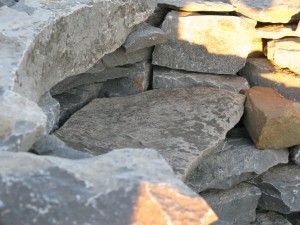
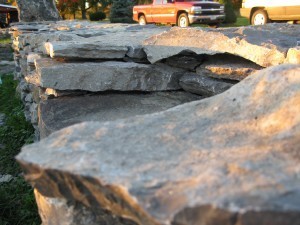
There are two benches hidden in the interior of the wall so that we can have a rest if the chores becomes too strenuous or even if we decide to sit and watch the seasons languish on the garden. The benches were created using rocks that had been naturally shaped over hundreds of years in the bed of a local river.
No matter where in life you take up residence, whether it be for a day, a month, or many years, you will always leave a bit of yourself behind. The choice is yours whether it is something negative or something positive, but rest-assured that at some point in the future, someone will find that remnant of you.


A fossil found in one of the stones and the artist's insignia on the cornerstone
Having watched the wall slowly emerge from a pile of rock over the last year, it reminded us that "built to last" is not an easy accomplishment. Rome was not built in a day, and neither was the great wall of Beekman.

October 8, 2010
A Head Above

Each of the ingredients of beer makes an obvious contribution to the finished product, be it ale, lager, porter, stout or any other type of beer. Interestingly, the smaller the proportion of each ingredient, the more difference it makes. Beer is mainly water and while the mineral content of the water can make more or less suited to extracting sugar from malt, the particular source does not make much difference to the flavor of the beer.
The type of malt (or types of malt) determines the body or "mouth feel" of the beer, its color and the basic flavor. One reason why most big brand beers (I won't name names, but you know who I mean) have so little flavor is that the malt is supplemented by other grains (corn or rice) that contribute more sugar at a lower price than barley but which contribute no flavor at all.
Hops, the dried resinous flowers (or strobiles) of a climbing vine called humulus lupulus contribute much of the aroma and bitterness to beer. At one time, beer was flavored with a host of ingredients from hops to orange peel, cloves and coriander seeds but eventually hops became the sole addition except in Belgium where many ancient traditions are kept alive in their myriad styles of beer. If someone says that he or she doesn't like beer, it is usually the flavor and aroma of hops that they object to.
Finally, the yeast determines the alcohol content and the way in which the beer must be made. Some yeasts form a think layer of foam on top of the beer as it ferments. This "top fermenting" yeasts ferment at relatively warm temperatures and result in beers with complex secondary aromas that can suggest fruit or flowers, the ale family. Other strains of yeast work at colder temperatures and do not collect on top of the beer. These "bottom fermenting" yeasts are responsible for the lager family, characterized by pure, clean aromas of hops, malt and very little else.
So where does the head come from and why do some beers have more foam than others? The head on a glass of beer, like the foam in soda and the bubbles in Champagne, results from carbon dioxide (a product of fermentation) that has been dissolved in the beer, escaping when released from the pressure of the bottles, can or keg. Some beers are naturally foamy and others are artificially carbonated (essentially turned into soda) when they are bottled. The nature of the head depends less on the amount of carbon dioxide than on the nature of the liquid it is escaping from.  For example, there is far more gas in a bottle of Champagne, and it is under far more pressure, than in a comparable amount of beer, but after the initial pop, the foam on a glass of Champagne disappears in a matter of seconds, whereas the head on a glass of beer can last considerable time. This is because in addition to extracting sugar from the malted barley, the mashing process also extracts proteins that bond together to form an invisible web that traps the gas as it tries to escape, resulting in longer lasting bubbles. Some grains contribute more of these than others. The addition of a small amount of malted wheat can result in a much more foamy product than one can get from barley alone because wheat contains a large amount of gluten. Gluten is a resilient and elastic protein that holds carbon dioxide bubbles better than any other. Not surprisingly then, the foamiest of all beers are wheat beers that must be very carefully poured if one doesn't want to end up with a glass of nothing by foam. Don't even consider drinking a Heffeweizen from the bottle.
For example, there is far more gas in a bottle of Champagne, and it is under far more pressure, than in a comparable amount of beer, but after the initial pop, the foam on a glass of Champagne disappears in a matter of seconds, whereas the head on a glass of beer can last considerable time. This is because in addition to extracting sugar from the malted barley, the mashing process also extracts proteins that bond together to form an invisible web that traps the gas as it tries to escape, resulting in longer lasting bubbles. Some grains contribute more of these than others. The addition of a small amount of malted wheat can result in a much more foamy product than one can get from barley alone because wheat contains a large amount of gluten. Gluten is a resilient and elastic protein that holds carbon dioxide bubbles better than any other. Not surprisingly then, the foamiest of all beers are wheat beers that must be very carefully poured if one doesn't want to end up with a glass of nothing by foam. Don't even consider drinking a Heffeweizen from the bottle.
Essentially the head on a glass of beer is not very different from bread dough (although far thinner and more delicate) and what you see happening on top of your glass is very similar to what happens when the bread dough rises: Next time you make bread (yes, Josh and Brent make their own bread), notice the strong aroma of alcohol when you punch down the dough. And all of this raises the chicken-or-the–egg question of whether brewing beer was originally a byproduct of bread baking or vice versa.
It's an ongoing debate over which is the bigger vice.
Read more about our celebration of the brew. Click here.
October 3, 2010
In Memory of

Mary Beekman is a four-year-old ghost who resides in The Beekman Mansion, and considers Brent and Josh her "imaginary friends." Follow Mary Beekman's Diary each week to learn what it's like to be a young child in early 19th century America
While the sky was still quite grey and the morning not yet begun, Josh and Brent shook my arm. They whispered in my ear. No one can see or hear them so I am not certain why theywere speaking so quietly. They told me I should stay in my room longer than usual because Mother was weeping. Father had arrived home later than normal last night. I was in my bed with dolly. I was not quite asleep. The moon was large and bright. He had brought with him a letter for Mother from family. They do not live near by.
Josh and Brent were still here last night and said Mother opened the letter and began weeping softly. Father was very concerned. Mother is a very sensitive woman with compassion that knows no boundaries. I believe these are the very reasons she has so many friends and folks who come to visit and seek her council. I do not feel comfortable when she is sad.
The eldest child of a distant relative had ended his life by his own hand. I think he was the same number of years as older brother who is 18. I am not to speak of it to Mother. She cannot understand how this could happen. Mother says all life is a gift to be honored and cherished. When I saw Mother later this day, she was in her room just rocking and weeping into her handkerchief. She bade me to come in and hugged me close. She smelled of violets and sadness. I did as Father told me and did not speak. She kept whispering of his despair and loneliness. I did not even seek the name of this young man. Mother told me the name of this boy would be written in the sky of the beautiful painting that is in our parlor. He had painted this picture.
Josh and Brent and I went in to see the painting. We needed to take a closer look. It was sent to our family as a gift when our house was completed. Father was always proud of this young man's talent. We looked at the sky from every direction. We walked back and forth and Brent and Josh even tipped upside down to see what name they could discover. It was rather strange, because we could read many names in the wisps of clouds and streams of smoke coming from hearth chimneys. I had not discovered the loneliness in the beautiful, busy sky before. Now, I think I see it.
Hops to It
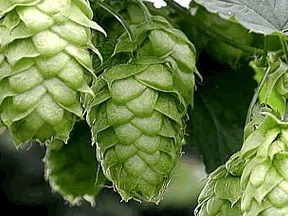
Around the middle of the 19th Century hops became an important crop in Sharon and the surrounding farms of Schoharie County. Hop growing was a delicate process and a considerable gamble for the farmer, but hop picking time in early September was a time of fun and frolic as well as hard work. Clerks and other city-dwellers spent their vacations in the country picking hops (agri-tourism!).
Such is the allure of a good brew.
Beer poses an interesting question for those who try to eat and drink local products. Unlike grapes, which must be picked at exactly the right time and crushed as soon thereafter as possible, none of the ingredients in beer is perishable. Malted barley and dried hops can last indefinitely, and even some yeast can be dried and packaged for long storage. Decent beer, in any style, can be made anywhere provided one can get deliveries of malted barley, hops and yeast. Even the hobby brewer, making beer in the garage on weekends, can select what kind of malt, hops and yeast to use. Consequently, Budweiser, Heineken and any number of famous beers are now brewed all over the world with precious little difference from brewery to brewery.
It wasn't always that way. Once upon a time, before paved roads and rail transport made it possible to move tons of freight to just about anywhere, beer was a truly local product and local produce determined the style. One used the local barley, malted in the only local facility, and local hops. Most importantly, before the science of microbiology explained the process of isolating and propagating the desired strain of yeast, brewers had to rely on whatever strain happened to be in the air or the cellar. And the local climate determined the temperature of that cellar, which determined whether the yeast was "top fermenting" or "bottom fermenting" and that determined whether one could use open tanks or had to use closed fermenters, and that determined a host of other elements. So, just as wine differs from village to village or vineyard to vineyard, beer once differed from village to village, brewery to brewery and monastery to monastery. (By the way, monks played as important a role in the development of brewing as they did in winemaking, which may explain why the small and very Catholic Bavarian city where my father was born had more breweries than churches.) So the Pilsner style – characterized, when made authentically, by very light color and the distinctive aroma of Saatz hops – would not have been likely to develop anywhere but Bohemia where those hops originated.
The microbrewery movement of the 80s and 90s was an attempt to return to this kind of individuality in American beer. But with all the world's ingredients now available to brewers, it is quite likely that at microbrewery near you, the only local ingredient will be the water. The barley used may come from Canada, the hops from Oregon, the yeast from a laboratory in Germany and the recipe from Scotland. And the ability to control temperature allows the brewer to determine the speed of fermentation and the style of the beer. So, except for the Lambic beers of Belgium, the only beers that are still made by spontaneous fermentation, anyone can brew any style of beer anywhere. How well they do it is another matter.
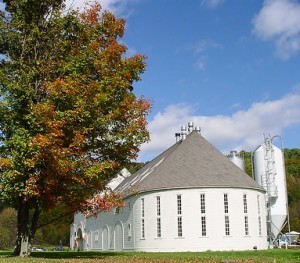
Brewery Ommegang
A case in point is one of our local breweries near Sharon Springs. Ommegang is an authentic Belgian style ale that is brewed in Cooperstown, New York. But the reason it is brewed there is a matter of pure coincidence. There is nothing about Cooperstown or the surrounding region that makes it especially suited to Belgian ale other than the fact that it is where the founders, a couple who imported Belgian beers, happened to live. They did it right. There is no question that the beer is excellent. It cannot be mistaken for any other beer and we are all proud that it comes from our neck of the woods. I even had the privilege of hosting the launch party for Hennepin ale, Ommegang's second offering, at my restaurant eleven years ago. The brewery is beautifully designed to resemble a Belgian farmhouse without feeling like a Disneyland. The project was a partnership with a prestigious Belgian brewery that sent one of their brewmasters to develop the recipe. They use the best ingredients from numerous far-flung sources. But how local is it? As I said, an interesting question to think about over a beer. Personally, I am more concerned with where my vegetables grow.
Read more about our month-long celebration of the brew. Click here
September 28, 2010
Mary and the Cheesemaker
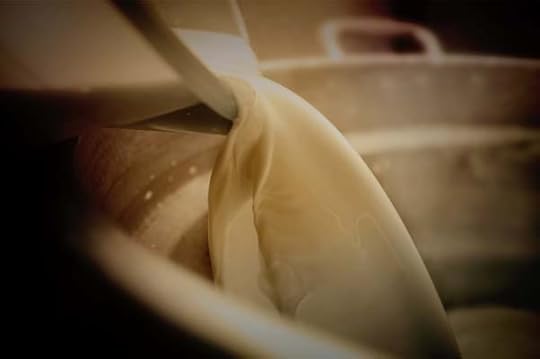
The daylight begins in a slower manner. The morning sun takes a different path across the floor of my room and does not warm the floorboards as it does in the summer. I, too, wish to begin my day in a slower manner; it is so warm under my covers. But I know today will be a long day. After my lessons, Mother is taking me to a farm nearby to watch the task of making cheese. Father said it is smelly work and not everyone makes a good cheese. The making of good cheese is not merely a task but a completion of a godly cycle. I am not certain what he is trying to tell me. He sells only the best tasting cheese in his store. The farmer's wife who puts her cheese in Father's mercantile receives store credits.
I hope Josh and Brent come along today to watch the making of cheese. They will not be underfoot. No one ever seems to notice them but me. They are my favorite friends. Mother has told me that one must pay careful attention to make a really fine cheese. She explained that fresh, raw milk is heated with rennet, which had been dried and saved from the fall slaughtering. Rennet comes from the stomach of a cow. Josh made a horrid face when Mother spoke about that. I watched the curd form on the mixture of heated milk and rennet. It took a long time. Josh and Brent and I walked about outside while we waited. Brent was leaping about, trying to catch a fly in his fist.
Then Mother called me into the dairy house to see the farmer's wife break the curds and begin to drain them. She worked in some butter and wrapped it in a cheese cloth before she placed it in a round mold and settled it in a cheese press. It seemed to take an hour. She would change and wash the cloths as the whey seeped out. The whey was smelly. It smelled sour to Josh and Brent and me. Brent said he was breathing through his mouth the entire time!!! She would repack the cheese in a dry cloth and put it back in the press for almost two days. We went home while the cheese was aging. But the attention to the cheese making would still continue.
Mother told me that the woman who is making the cheese will turn the ripening cheese each day and polish it with butter. Sometimes sage is used to flavor a new milk cheese. Father will only accept the best cheese in his store. Because I have a good, light hand with butter making, it is his hope I shall become proficient in the making of cheese. Josh and Brent have watched me making butter and singing. They tell me that I know how to speak to the milk that comes from the cow that feeds on our tender pasture………and that is what makes my butter turn sweet. I am really going to try to learn about this godly cycle. I think I can.
A person who works with their hands
is a laborer,
A person who works with their hands and head
is a craftsman,
A person who works with their hands, head, and heart
is an artisan!
-St.Francis
September 25, 2010
Oktoberfest in September?

We have our Sharon Springs Harvest Festival in September. Should we call it Oktoberfest instead?
The first Oktoberfest was held on October 12, 1810 as a public celebration of a royal marriage that had happened several days earlier. The main event was a horse race and, of course, there was plenty of food and drink. And, Munich being Munich, long recognized for the excellence of its breweries, that meant beer. The event proved so popular that it was repeated the following year and the year...
September 23, 2010
Critical Mass
See what the critics have to say about The Fabulous Beekman Boys and look for all new episodes in Spring 2011!!
September 21, 2010
Where Are They Now?

This turn-of-the century photo of the Beekman Mansion recently turned up in our e-mails.
Not too long ago, the director of the library in the neighboring village of Middleburgh sent us a photo of the Beekman Mansion from the turn of the 19th century.
Always interested in how the house has changed over the years, we immediately focused on a structure that seemed to be perched on the roof. The age of the photo made it difficult to see clearly. For weeks it remained a mystery.
Then one late...
September 7, 2010
A Bumper Crop

Empty Jars lined up waiting to be filled.
Anyone who read my most recent memoir, The Bucolic Plague, knows that late 2008 through mid 2009 were a pretty tough time for Brent and I. We both lost our jobs, our savings were dwindling, and we were trying to pay for two mortgages with soap. All of these misfortunes were pretty horrible. But then came the final blow. In early summer. The Great Tomato Blight of 2009.
I can persevere through a lot. I've driven myself to hospitals twice for emergency...
September 4, 2010
Mary's Spring House
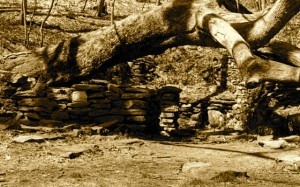
Mary Beekman is a four-year-old ghost who resides in The Beekman Mansion, and considers Brent and Josh her "imaginary friends." Follow Mary Beekman's Diary each week to learn what it's like to be a young child in early 19th century America
The older boys and the men who work on the farm are gathering large rocks for Mother's spring house. They are loading them onto the stone boat. They find the rocks at the edges of the fields or the woods. The barns are finished and our house is...



